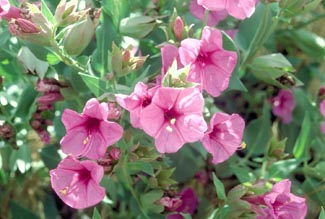Four O'clock

Common Name(s):
Four O’clock
Four-o-clock
Scientific Name:
Mirabilis sp. L.
Scientific Name Synonyms:
Some species have Scientific Name Synonyms, see http://plants.usda.gov about specific species.
Symbol:
MIRAB
Description:
Life Span: Perennial
Origin: Native (except Mirabilis jalapa ~ Marvel of Peru is introduced)
Growth Characteristics: Most species of Four o’clock grow 2-3 feet tall. Smooth spreading four o’clock (Mirabilis oxybaphoides) spreads along the ground, sometimes to many feet in diameter, and several feet high. Colorada four o’clock (Mirabilis multiflora) forms an eye-catching large bush-like mass of dense foliage up to 3 or 4 feet wide and high. All four o’clocks die back to the roots each year.
Flowers/Inflorescence: Flowers throughout the four o’clock family vary widely in color, from white to yellow, to pink, to magenta. All flowers are funnel-shaped, with 5 lobes and 3 long stamens which either extend out beyond the flower, or coil inside of the flower. Flowers occur in clusters of 1-5, most having 2-4. These flowers have no corolla, and it is the calyx that is colored. Each individual flower or cluster of flowers is surrounded by a whorl of bracts termed an involucre. These bracts, which resemble sepals, have apparently evolved from flowers originally found in clusters of three, where only one flower would develop to maturity. Smooth, spreading four o’clock (Mirabilis oxybaphoides) always has 3 flowers to a cluster, and the buds and bracts have sticky hairs. Colorado four o’clock (Mirabilis multiflora) also has flowers usually clustered in threes. Several species in this genus (Mirabilis) have flowers which open during the late afternoon, which is why they have the common name, "Four O'Clock".
Fruits/Seeds: At maturity, the calyx swells and ripens into a 5-angled fruit containing yellowish-brown achenes. The five-ribbed fruits are about 3/16 inch long.
Leaves: Leaves vary in shape, from narrowly linear (in Mirabilis linearus) to oval or heart shaped (Mirabilis bigelovii, M. oxybaphoides M. nyctaginea, M. multiflora). Leaves occur opposite on the stems and have a short petiole. Leaf color ranges from grayish-green to dark green and the leaves have smooth edges. Some leaves are hairy, others are glabrous.
Stems: Most species of four o’clock have erect, branching stems with conspicuous nodes that are particularly evident after leaf drop. Stem colors are a range of shades of green. Stems are often 4-sided but are not as square as those of plants in the mint family. The stems of Wishbone-bush (Mirabils bigelovii) are weak, very stick, and form “wishbone” patterns. The stems of Smooth spreading four o’clock (Mirabilis oxybaphoides) spread along the ground.
Roots: Most species have a deep, woody taproot crowned with a branching structure called a caudex. Marvel of Peru (Mirabilis jalapa) roots are fibrous. The roots of Heart-leaf four o’clock (Mirabilis nyctaginea) are thick and black, and it’s taproot is often 3 inches or more in diameter.
Ecological Adaptions:
Flowers open in the evening for insects that are out in the evening and night. Plants seem to thrive under grazing, perhaps because of its ability to colonize sites where soil is disturbed. Elevations ranges vary widely by species.
Soils: All native species of Four o’clock prefer dry, sandy, or gravelly soils. The introduces species, Marvel of Peru (Mirabilis jalapa), prefers consistently moist, well-drained soils.
Associated Species: Pinyon Pine, Utah juniper, blackbrush.
Uses and Management:
All parts of Marvel of Peru (Mirabilis jalapa) are poisonous if ingested.
Native Americans have used Colorado four o’clock (Mirabilis multiflora) for dyes and medicinal properties, both in prehistoric times and modern day. The Navajos boil the flowers to make a light brown or purple color for dying wool. The Hopis used the roots of older plants to make a blood-strengthening tea for pregnant women. Teas were also made to treat colic, eye infections, muscle soreness, body swellings, rheumatism and indigestion. The Acoma and Laguna pueblo tribes dried the leaves for smoking material, and some say the plant has a sedative property.

